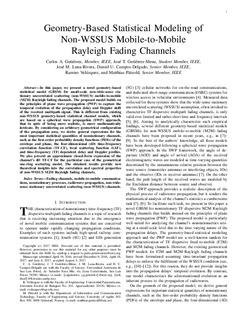| dc.contributor.author | Gutierrez, Carlos Adrian | |
| dc.contributor.author | Gutierrez-Mena, Jose Trinidad | |
| dc.contributor.author | Luna-Rivera, Jose Martin | |
| dc.contributor.author | Campos-Delgado, Daniel Ulises | |
| dc.contributor.author | Velazquez, R. | |
| dc.contributor.author | Pätzold, Matthias Uwe | |
| dc.date.accessioned | 2018-03-20T13:45:40Z | |
| dc.date.available | 2018-03-20T13:45:40Z | |
| dc.date.created | 2017-07-26T12:25:03Z | |
| dc.date.issued | 2018 | |
| dc.identifier.citation | IEEE Transactions on Vehicular Technology 2018 Volume 67;1 | nb_NO |
| dc.identifier.issn | 0018-9545 | |
| dc.identifier.uri | http://hdl.handle.net/11250/2491298 | |
| dc.description.abstract | In this paper, we present a novel geometry-based statistical model for small-scale non-wide-sense stationary uncorrelated scattering (non-WSSUS) mobile-to-mobile (M2M) Rayleigh fading channels. The proposed model builds on the principles of plane wave propagation to capture the temporal evolution of the propagation delay and Doppler shift of the received multipath signal. This is different from existing non-WSSUS geometry-based statistical channel models, which are based on a spherical wave propagation approach, that in spite of being more realistic is more mathematically intricate. By considering an arbitrary geometrical configuration of the propagation area, we derive general expressions for the most important statistical quantities of nonstationary channels, such as the first-order probability density functions of the envelope and phase, the four-dimensional (4-D) time-frequency correlation function (TF-CF), local scattering function (LSF), and time-frequency-dependent delay and Doppler profiles. We also present an approximate closed-form expression of the channel's 4-D TF-CF for the particular case of the geometrical one-ring scattering model. The obtained results provide new theoretical insights into the correlation and spectral properties of non-WSSUS M2M Rayleigh fading channels. | nb_NO |
| dc.language.iso | eng | nb_NO |
| dc.publisher | IEEE | nb_NO |
| dc.title | Geometry-Based Statistical Modeling of Non-WSSUS Mobile-to-Mobile Rayleigh Fading Channels | nb_NO |
| dc.type | Journal article | nb_NO |
| dc.type | Peer reviewed | nb_NO |
| dc.description.version | acceptedVersion | nb_NO |
| dc.source.pagenumber | 362-377 | nb_NO |
| dc.source.volume | 67 | nb_NO |
| dc.source.journal | IEEE Transactions on Vehicular Technology | nb_NO |
| dc.source.issue | 1 | nb_NO |
| dc.identifier.doi | 10.1109/TVT.2017.2737952 | |
| dc.identifier.cristin | 1483145 | |
| dc.relation.project | Norges forskningsråd: 261895 | nb_NO |
| dc.description.localcode | nivå2 | nb_NO |
| cristin.unitcode | 201,15,4,0 | |
| cristin.unitname | Institutt for informasjons- og kommunikasjonsteknologi | |
| cristin.ispublished | true | |
| cristin.fulltext | postprint | |
| cristin.qualitycode | 2 | |
